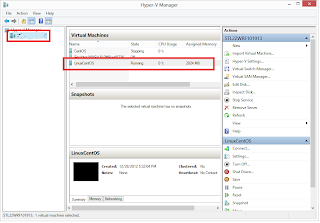Before jumping into Hyper-V, you will want to make sure you have a system which will support it. Here are a few links to help.
http://blogs.msdn.com/b/taylorb/archive/2008/06/19/hyper-v-will-my-computer-run-hyper-v-detecting-intel-vt-and-amd-v.aspx
64-bit Windows 8 Pro supports Hyper-V and after you install it, you will need to enable Hyper-V. This is done using the control panel, selecting programs, then choosing Turn Windows Features on or off
From Windows Features, a dialog will present you will a number of options. If your system supports hyper-v, then it will be available for you to enable.
The hyper-v manager should now be accessible from the start screen.
Now, the fun can begin! Launching the manager will give you access to create VMs. This is very cool and, as I mentioned, is part of the Windows 8 Pro operating system. You don't have to install any 3rd party software packages or costly virtual machine emulators. The screen shot, below, is from my Dell laptop running Win8. I have three VMs installed and the highlighted one is the Linux OS, CentOS.
It is very easy to create your own VM and Microsoft has done an excellent job providing a wizard approach to configuration. This blog entry just highlights the hyper-v feature and more details may follow with another blog entry.
But wait, there's more!
Before I wrap this up, I do want to bring to your attention another fantastic feature of Windows 8. Once you download the ISO you wish to install, all you have to do is right-click the ISO file, then select Mount. Mounting ISO files is a feature which is part of Windows 8. No longer needed are additional applications to help with using ISO files. Your mounted ISO will show up as a drive letter.
But wait, there's more!
Before I wrap this up, I do want to bring to your attention another fantastic feature of Windows 8. Once you download the ISO you wish to install, all you have to do is right-click the ISO file, then select Mount. Mounting ISO files is a feature which is part of Windows 8. No longer needed are additional applications to help with using ISO files. Your mounted ISO will show up as a drive letter.
I'll leave you with a final screen shot. It is from my VM, running CentOS. Enjoy!






